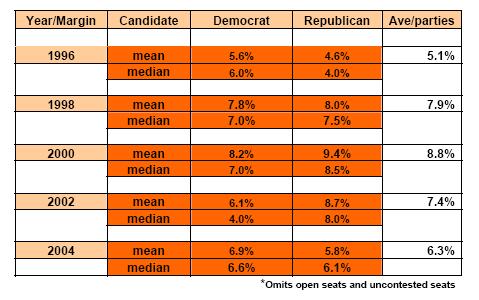Incumbency Bumps
The Typical Incumbent Advantage, 1996-2004
Most incumbents not only represent districts leaning in their party’s favor; their incumbency also tends to give them an advantage, based on a combination of name recognition from past campaigns, more campaign money, their ability to win support from constituents by helping them on non-ideological issues and regular franked mailings to their constituents about how well they are serving their district. Looking at elections from 1996 to 2004, FairVote found that incumbents on average won just over 7% above their projected partisanship, translating into a 14% average increase in their victory margin. The differences between the parties in certain election years suggest that those were ones years in which one party had a slight edge in the two-party national popular vote – with Democrats preferred in 1996 by about 1.5%, for example, and Republicans preferred in 2002 by about 3%.

Overall average for parties & years: 7.1%
